Heal Your Emotional Wounds by Exploring the Mother Gap
What we needed and did not receive in childhood is what Bethany Webster calls the “mother gap” — a concept we’ll focus on in this article, part three of our Attachment Wounds and Food Struggles series. Your mother gap may be the result of enmeshment, or it may be another type of misattunement mentioned in part one of this series. Regardless of the type of misattunement experienced, the healing work requires identifying it as a wound and leaning into the awareness and pain by becoming familiar with it and how it manifests today rather than sweeping it under the rug. Although we will try, the mother gap cannot be rectified by turning to food, a partner, a child, wealth, or status. So where can you start? Keep reading to learn more about the mother gap and how to heal from your emotional wounds.
How Do I Heal My Emotional Wounds?
“Firefly Lane” on Netflix demonstrates the prolonged pain and struggle that occurs when we try to sweep emotional wounds under the rug. Katherine Heigl’s character, Tully, carries an excruciatingly painful mother gap that she attempts to shut out by pursuing wealth and status. As a child, she was emotionally neglected and spent most of her time vacillating between being the responsible parent figure to her single mother with addiction, holding out hope that her mother would finally prioritize her over drugs and men, wondering who her father is, and feeling abandoned during stints of time living with her grandmother.
The relational blueprint that trailed Tully into adulthood was defined by her mother’s inconsistent, chaotic, and unreliable presence, love, and nurturing — and it drives Tully’s insatiable need to be seen and adored as a young adult. In pursuit of rectifying the mother gap, Tully chases fame as a top journalist and beloved talk show host. She soaks up the power and control that accompanies her status and brushes off men who genuinely care for her so she doesn’t find herself back in a vulnerable state of relying on or being disappointed by others. The relational trauma and mother gap Tully disowns becomes the shadow that drives her toward a shallow, inauthentic, and invulnerable life that is heavily medicated with work, sex, alcohol, and an anxious clinging to a boundaryless, enmeshed friendship.
In order to live in a more easeful, settled, genuine way, we need to bridge our own mother gaps by recognizing the relational trauma and emotional wounds we carry and learning to give ourselves what we’ve been missing.
In my work, I help my clients:
Explore, process, and grieve their mother gap
Understand the relational trauma and attachment wounds they experienced and how this trauma has consciously and unconsciously impacted their self-perception, choices, etc.
Identify the ways food and other behavior/life choices were a symptom of their emotional wounds and the role these choices played to soothe and protect in the moment
Examine and engage the younger and older, wiser parts of themselves to establish a more integrated, whole sense of self
Bring a compassionate, mindful perspective to present-day patterns with food, self-neglect, etc.
Form a nurturing bond with themselves as a way to heal and release the charge around food and the pain they’ve been carrying
What We Can Hope For
You get the meal your soul has been longing for by engaging in the process of healing the Mother Wound and owning your life and your worth. —Bethany Webster, “Discovering the Inner Mother”
When we’re patient, consistent, and committed to ourselves and the process — and we’re supported (more on what that looks like in part four) — there’s a point at which we’ll move from anger, frustration, rumination, desperation, and longing for others to meet our needs to proactively attending to our needs. There’s skill involved in this transition, but our point of reference changes when we begin to get the validation, acknowledgment, and companionship from inside. We feel a sense of hope, competency, responsibility, and power returning to replace the disempowerment, vacancy, and smallness we once felt.
Filling this mother gap from within is about zooming out to recognize we are made up of many parts. Among them lies a younger part that’s in pain and has been neglected. There’s also a nurturing part of us — the inner mother — that may be dormant or underdeveloped due to enmeshment or other traumas. We can learn to cultivate this nurturing, compassionate, and loyal-to-self part of us to attend to the younger part. From there, we begin to fill that vacuum — the void in us that develops as a result of ignoring our pain and needs over time — with something real that only we know we need and only we can provide.
I often find myself saying in session that we bring the unconscious to the conscious level by talking about and linking together our pain, childhood attachment wounds, and subsequent behavioral patterns. Becoming conscious of emotional dynamics allows greater understanding and compassion for ourselves and gives us leverage to be less hooked by them over time.
If this exploration has you thinking about your mother gap and emotional wounds, consider reflecting on these questions:
What did I need from my parents or caregivers that I did not get? In what ways may I be unconsciously projecting these needs onto other people (e.g. my child, partner, work colleagues, friends, etc.)?
What have I filled that empty vacuum with?
Am I getting the mothering and nurturing I need in my daily life? If not, what’s one thing I can commit to doing this month to get those needs met?
Steps Forward
While it may feel like reflecting on the past is counterproductive, it helps identify:
The unconscious and ineffective ways we try as adults to remedy the attachment wounds and unmet needs from childhood
Steps we can take to become a more whole person today who is able to live in the present
With time and support, the bridge we build between our past and present reminds us that we’re in a different place today and we have the agency and resources to give ourselves what we’ve been missing. Head to the fourth and final article of the series - a Q&A - for resources, tools, and perspectives to help you do this.

